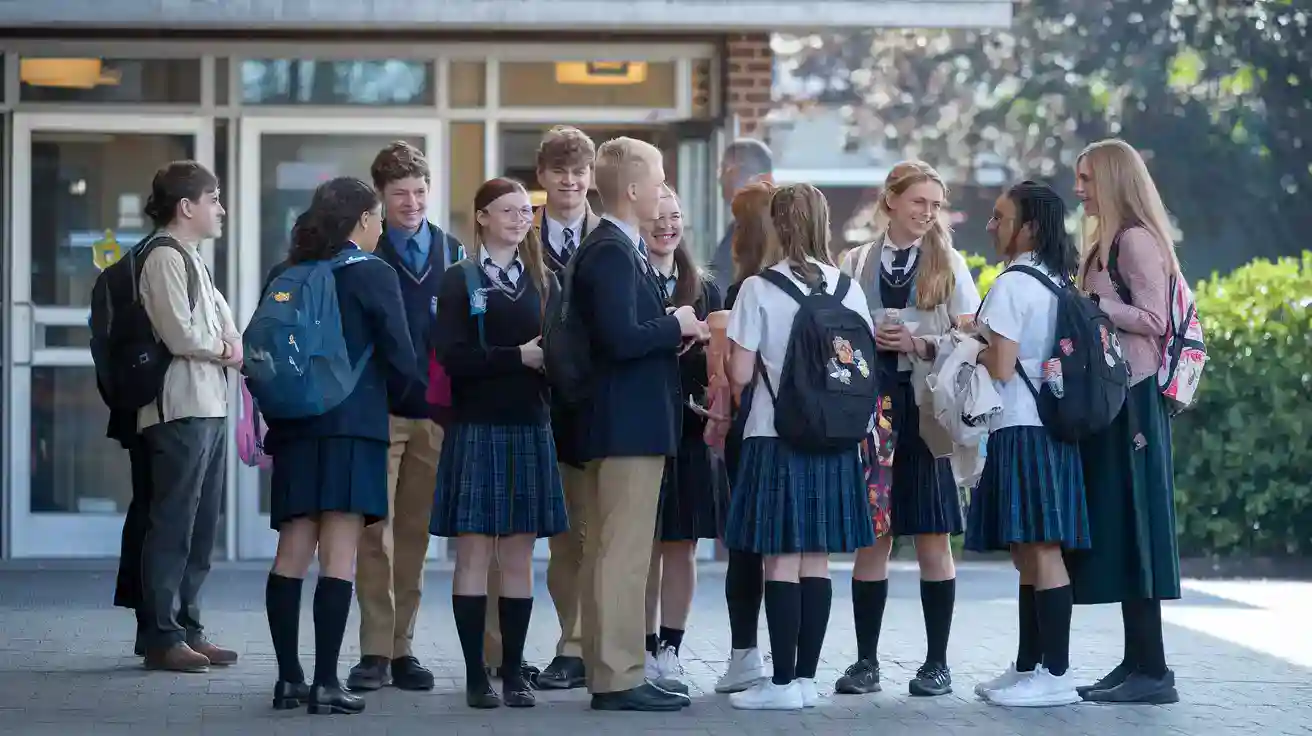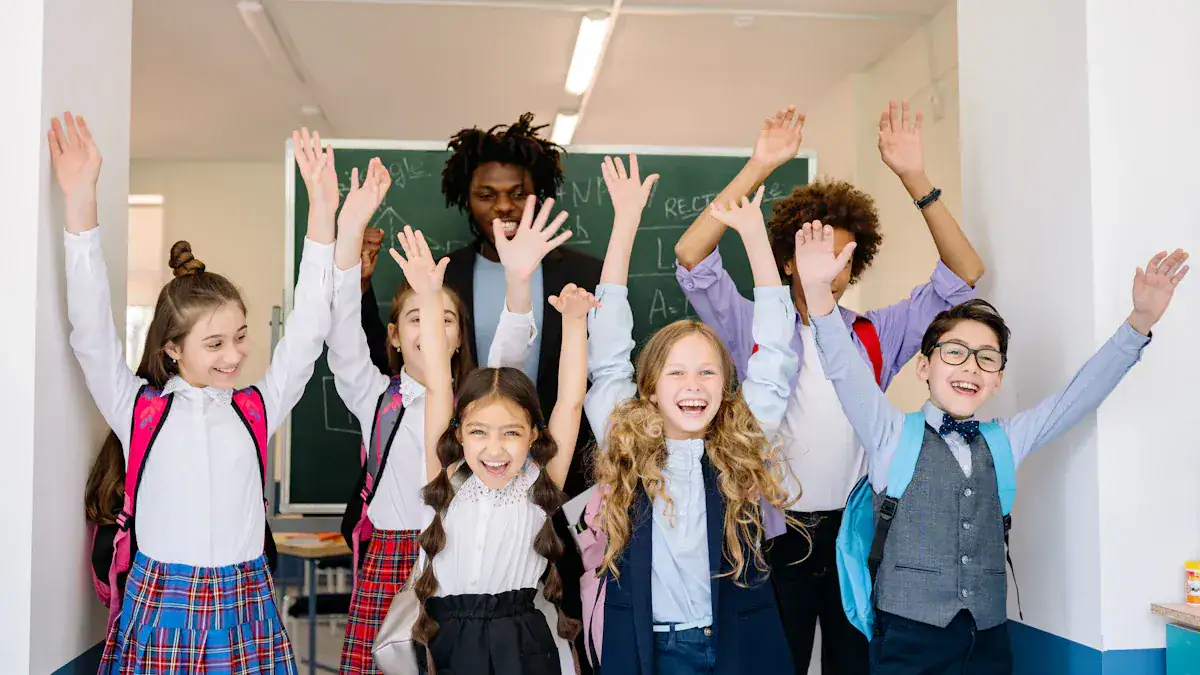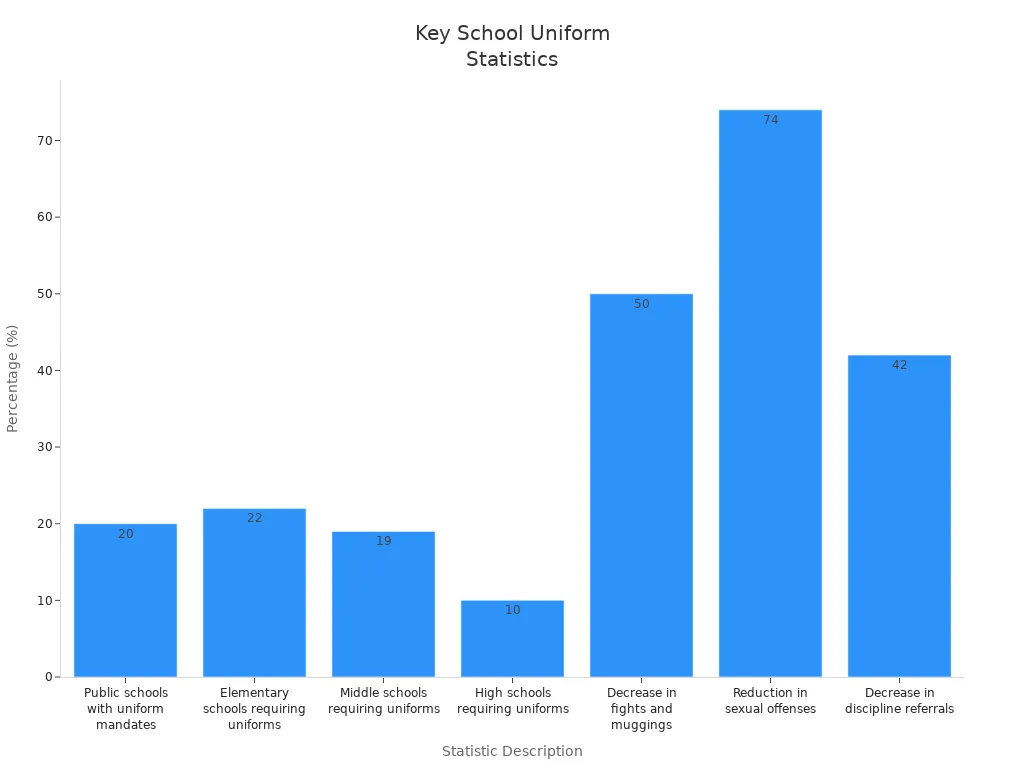Should schools have uniforms

When I consider whether schools have uniforms, I see a question that sparks strong opinions. Over the past two decades, more American schools adopted uniforms, rising from 12% in 1999–2000 to 18.8% by 2019–20. The debate centers on how uniforms affect students and the overall impact on school culture. Many educators argue uniforms reduce bullying and foster unity, while others believe they restrict self-expression and do not improve academic behavior.
Here are some of the most cited reasons in policy discussions:
Reasons For School Uniforms | Reasons Against School Uniforms |
|---|---|
Reduces competition and bullying based on appearance (83% of teachers support this) | Not effective in changing behavior or academic achievement |
Fosters a sense of belonging and unity among students | Students dislike uniforms, finding them ugly and uncomfortable |
Can lower clothing costs for families | Restricts freedom of expression and self-exploration |
Prevents display of gang colors, enhancing safety | Can lead to increased costs for families with limited budgets |
Key Takeaways
School uniforms can reduce bullying and peer pressure, creating a safer environment for students.
Uniforms promote a sense of belonging and unity, helping students feel more connected to their school community.
Wearing uniforms can minimize distractions, allowing students to focus better on their studies and improve academic performance.
Uniform policies can help reduce visible socioeconomic differences, fostering equality among students.
Some students feel that uniforms limit their self-expression and personal style, which can impact their self-identity.
The financial burden of purchasing uniforms can be significant for families, leading to stress and sacrifices.
Schools should consider flexible policies, such as dress codes or hybrid models, to balance uniformity with personal expression.
Community input is essential in shaping uniform policies, ensuring they meet the diverse needs of students and families.
School Uniforms: Pros

Equality
Socioeconomic Differences
When I look at the impact of school uniforms, I see a clear advantage in reducing visible socioeconomic differences among students. Uniform policies create a level playing field. I have noticed that when everyone wears the same outfit, it becomes harder to judge classmates based on brands or fashion trends. This shift can help students feel more comfortable and accepted in their environment.
Study | Findings |
|---|---|
Draa, 2005; Gentile & Imberman, 2011; Hoffler-Riddick & Lassiter, 1996 | Better school attendance in uniform schools |
Han, 2010; Hoffler-Riddick & Lassiter, 1996; Pate, 2006; Peters, 1996 | Decline in disciplinary infractions and higher sense of belonging |
I have seen that better attendance and a stronger sense of belonging often lead to improved academic performance. These benefits show why many educators support uniform policies.
Peer Pressure
Peer pressure can shape a student’s school experience. I remember how much stress some students felt to keep up with the latest trends. Uniform policies help reduce this pressure. According to recent surveys, 72% of parents and 86% of school officials believe that school uniforms decrease peer pressure. This reduction allows students to focus on their studies instead of worrying about fitting in.
Uniforms help students feel less judged by their appearance.
Many students report feeling more included when everyone dresses the same.
A study by Dr. Jafeth Sanchez and George “Gus” Hill found that discipline, gang activity, and bullying decreased after uniform implementation.
I believe that when students feel less pressure to compete over clothing, they can build stronger, more genuine friendships.
Focus
Distractions
Distractions in the classroom can hurt academic performance. I have observed that school uniforms help minimize these distractions. Students spend less time thinking about what to wear and more time paying attention to lessons. The Arizona Court of Appeals upheld a mandatory school uniform policy, noting that it reduced clothing distractions and improved campus safety.
Evidence Type | Description |
|---|---|
Court Ruling | The Arizona Court of Appeals upheld a mandatory school uniform policy, citing reduced clothing distractions and improved campus safety. |
Testimony | Testimony indicated that uniforms improved school spirit and reduced the time staff spent enforcing dress codes. |
In my experience, teachers spend less time dealing with dress code violations when uniform policies are in place. This change gives students more time to focus on learning.
Study Time
Uniform policies also help students use their time more efficiently. Without the daily decision of what to wear, students can start their day with less stress. I have seen that this routine helps students arrive at school ready to learn. Studies show that students in uniforms display increased attentiveness to teachers and better discipline. These factors contribute to a more productive learning environment and can lead to higher academic performance.
School uniforms promote a sense of belonging among students.
They help minimize distractions related to clothing choices, allowing students to focus better on their education.
Uniform policies contribute to creating an equitable learning environment.
I believe that these benefits make a strong case for adopting school uniforms, especially when the goal is to promote safety, improve academic performance, and support student well-being.
Community
Belonging
When I walk into a school where everyone wears school uniforms, I notice a strong feeling of belonging. I see students connect over shared attire, which helps new students feel welcome from the first day. School uniforms create an environment where students feel part of something bigger than themselves. I have observed that when everyone dresses the same, it becomes easier for students to form friendships and feel accepted.
Uniforms reinforce the idea that all students are equal in the classroom, leading to a more respectful and inclusive culture.
Parents often tell me that seeing their children in school uniforms lifts their spirits. They feel proud when their children represent the school, and this pride strengthens the bond between families and the school community. I believe that school uniforms help students focus on learning and building relationships, rather than worrying about fitting in through fashion.
Unity
School uniforms play a key role in promoting unity. I have seen how uniforms encourage students to participate in school traditions and events. When students wear the same colors and styles, they show support for their school and classmates. This shared experience builds trust and teamwork.
School uniforms promote school traditions that enhance cohesiveness and individual belonging.
They help avoid distractions by ensuring everyone looks the same, which fosters equality among students.
Parents feel a sense of community when they see their children in uniforms, boosting their spirits.
I notice that school uniforms help students work together and support each other. The sense of unity extends beyond the classroom. During sports games, assemblies, and field trips, students feel proud to represent their school. School uniforms make it easier for students to identify with their peers and feel included.
Uniforms create a sense of community by encouraging students to connect over shared attire.
They help new students feel immediately integrated into the school environment.
In my experience, school uniforms help students develop a strong sense of community. This unity leads to better cooperation, less conflict, and a more positive school atmosphere.
School Uniforms: Cons
Self-Expression
Personal Style
When I reflect on the impact of school uniforms, I see how they restrict personal style. Clothing gives students a way to show their personality and creativity. Uniform policies remove the ability to make choices about appearance. I notice that students lose the chance to express themselves through fashion, which can feel limiting.
They send the message that conformity matters more than individuality.
Students miss out on practice making personal clothing choices.
I have observed that students educated under strict uniform policies often struggle to develop their own identities. Clothing serves as a powerful medium for self-expression. When students must wear the same outfit every day, they may find it harder to form a sense of self that stands apart from the group.
Identity
Uniform policies can affect how students view themselves. I have seen students feel embarrassed when uniforms do not fit their body type. This discomfort can lower self-image and hinder self-expression. A study from Arizona State University found that students in schools with uniform policies had a lower self-perception compared to those in schools without such policies. This suggests that uniforms may negatively impact self-image and identity development.
Uniforms decrease a sense of self-expression among students.
There is a lack of research on how uniforms affect students’ ability to express themselves.
Embarrassment due to mismatched body types can hinder self-expression.
I believe that when students cannot choose their clothing, they lose an important way to express their identity. This drawback deserves careful consideration.
Comfort
Physical Issues
Comfort plays a major role in student well-being. I have noticed that students in stiff, uncomfortable uniforms tend to fidget more. This behavior leads to distracted learning and lower engagement in class. Uniform policies often require materials that do not suit every student’s needs. Some students feel restricted and uncomfortable throughout the day.
Students in uncomfortable uniforms fidget more, which distracts them from learning.
Comfortable clothing boosts confidence and helps students focus on their work.
I see that when students feel at ease in their clothing, they participate more actively in class and school activities.
Weather
Uniform policies rarely account for changes in weather. I have seen students struggle with heavy fabrics during hot months or thin materials in cold weather. This lack of flexibility can make students uncomfortable and affect their ability to concentrate. Activewear-inspired uniforms encourage participation in physical activities, as students feel more at ease transitioning from class to recess or gym. However, most traditional school uniforms do not offer this level of comfort.
Cost
Affordability
The cost of school uniforms can create a financial burden for families. I have spoken with parents who spend hundreds of dollars each year on uniforms. In England, parents spend an average of £422 annually on uniforms for secondary school children and £287 for primary school children. Estimates for uniform costs vary widely, ranging from £100 to over £400 per child depending on the survey.
Uniform costs can range from £100 to over £400 per child.
Many families struggle to afford multiple sets of uniforms.
I believe that uniform policies should consider the financial impact on families, especially those with limited budgets.
Family Burden
Uniform policies can increase stress for families. I have seen parents worry about buying new uniforms when children grow or when styles change. Some families must purchase uniforms for more than one child, which adds to the expense. The need to buy specific items from approved suppliers can make uniforms even more costly.
Mixed Research on Behavior and Discipline
Research on the impact of school uniforms on behavior and discipline shows mixed results. I have read studies where schools with uniform programs reported better attendance and fewer minor behavior infractions. However, these same schools sometimes had lower standardized math scores and more significant behavioral issues compared to schools without uniforms.
Uniform policies may improve attendance and minor discipline.
Some schools with uniforms report more serious behavioral infractions.
The benefits of school uniforms are not straightforward and reflect mixed results in existing literature.
I believe that while uniform policies offer some advantages, the drawbacks—such as limiting self-expression, causing discomfort, and creating financial concerns—must be weighed carefully. The evidence does not show a clear link between uniforms and improved behavior or academic achievement.
Should Schools Have Uniforms: Comparison
Well-being
Confidence
When I evaluate the effect of school uniforms on confidence, I notice both positive and negative outcomes. Uniform policies often increase self-esteem for many students. Wearing the same attire as classmates can help students feel accepted and valued. I have seen students walk into school with more confidence, knowing they will not be judged by their clothing choices. On the other hand, some students feel that uniforms stifle individuality. They lose a way to express their personality, which can lower self-confidence for those who value personal style.
Stress
Uniform policies can reduce stress in the mornings. I remember how much easier it felt to get ready for school when I did not have to decide what to wear. This simplicity saves time and lowers anxiety about fitting in. However, I have also observed that uniforms can create stress for families who struggle to afford them. The financial burden of purchasing multiple sets of uniforms can weigh heavily on parents. Some students feel uncomfortable in uniforms that do not fit well, which adds to their daily stress.
Academic Impact
Achievement
I have reviewed research showing that school uniforms may contribute to improved academic achievement. Uniform policies help minimize distractions, allowing students to focus more on their studies. I have noticed that classrooms with uniforms often have fewer disruptions related to clothing. This environment supports better concentration and can lead to higher test scores. However, some studies suggest that the link between uniforms and academic achievement is not always strong. The impact varies depending on the school and the students involved.
Motivation
Uniform policies can influence motivation in different ways. I have seen students feel more motivated to participate in school activities when they feel part of a unified group. The sense of belonging encourages engagement and school spirit. Yet, some students report feeling less motivated when they cannot express themselves through their clothing. The lack of choice may make school feel less personal and more restrictive.
Social Life
Bullying
School uniforms play a role in reducing bullying and peer pressure. I have witnessed fewer incidents of teasing based on clothing brands or styles in schools with uniform policies. Students feel less pressure to keep up with fashion trends, which creates a safer and more inclusive environment. According to surveys, uniforms help decrease bullying and promote equality among students.
Inclusion
Uniform policies foster inclusion by creating a sense of community. I have seen students bond over shared attire, which helps new students feel welcome. However, uniforms may also exclude those who wish to express religious or cultural identities through their clothing. The challenge lies in balancing inclusion with respect for individuality.
Here is a side-by-side comparison of the most relevant arguments for students:
Pros of School Uniforms | Cons of School Uniforms |
|---|---|
Reduces bullying and peer pressure | Stifles individuality and self-expression |
Increases self-esteem | Limits choice of dress codes |
Improves school image | May violate religious expression |
Saves time in the mornings | Can create financial burdens |
Uniform policies encourage discipline and set clear rules.
They promote comradery and foster a sense of community.
Uniforms make it easier for students to get ready in the morning.
Uniforms can be financially advantageous for parents.
When I weigh these arguments, I find that the most relevant factors for students include the impact on academic achievement, well-being, and social inclusion. School uniforms offer benefits in reducing bullying and promoting focus, but they also limit self-expression and may create financial challenges. The decision to implement uniform policies should consider the diverse needs and experiences of students.
Impact on Students

Learning
Focus
When I observe classrooms with school uniforms, I notice students spend less time worrying about their appearance. This shift allows them to concentrate on lessons and participate more actively. I have seen students arrive at school ready to learn, without the distraction of choosing outfits. Uniforms help create a consistent environment, which supports better focus throughout the day. Many students report feeling less anxious about fitting in, which helps them pay attention to teachers and assignments.
Achievement
I often review studies that examine the relationship between school uniforms and academic achievement. Longitudinal research shows mixed results. For low-income students, uniforms improve attendance, but academic achievement does not show significant improvement. For the general student population, uniforms do not lead to notable gains in grades or test scores.
Student Demographic | Impact of School Uniforms on Attendance | Impact on Social Skills/Behavior | Impact on Academic Achievement |
|---|---|---|---|
Low-Income Students | No significant improvement | No significant improvement | |
General Student Population | No significant improvement | No significant improvement | No significant improvement |
I believe that while uniforms help students arrive at school more consistently, they do not guarantee higher academic performance.
Social
Friendships
School uniforms influence how students form friendships. I notice that uniforms help eliminate divides based on clothing, which encourages students to connect over shared interests. This environment fosters a sense of community and inclusivity. Students often feel more comfortable approaching peers, knowing that fashion does not separate them.
Aspect | Influence on Social Interactions |
|---|---|
Reduction of Social Barriers | Uniforms help eliminate divides based on clothing, fostering friendships based on shared interests. |
Inclusivity | Creates a more inclusive atmosphere, encouraging connections beyond fashion. |
Clique Formation | Helps break down cliques, promoting a greater sense of community among students. |
Cliques
Uniform policies aim to reduce cliques and promote unity. I see schools use uniforms to create a sense of belonging and minimize social barriers. However, some students feel alienated in uniformed environments. The restriction on self-expression can lead to feelings of confinement and loss of individuality. While uniforms break down some cliques, they may also create new divisions based on other factors.
Schools aim to create a sense of community and reduce cliques through uniforms.
Some students report feeling alienated and less belonging in uniformed environments.
The restriction on self-expression can lead to feelings of confinement and loss of individuality.
Behavior
Discipline
I have witnessed changes in student behavior after the introduction of school uniforms. At Sparks Middle School, discipline referrals dropped by about 10% in the first year. Police log reports decreased by 63%. Many students reported fewer incidents of bullying and felt safer in their environment.
Evidence Type | Description |
|---|---|
Discipline Reduction | Discipline referrals reduced by about 10% in the first year after uniform policy implementation at Sparks Middle School. |
Police Report Reduction | A 63% reduction in police log reports was noted during the first year of uniform implementation. |
Student Perception | 30-40% of students reported benefits from wearing uniforms, including a reduction in bullying. |
Attendance
Uniform policies also affect attendance. I have seen better attendance rates in schools with uniforms, especially among low-income students. Uniforms remove barriers related to clothing, making it easier for students to attend regularly. However, improvements in attendance do not always translate into higher academic achievement.
Wearing uniforms can boost students’ confidence and help them feel a sense of belonging. Uniforms reduce the fear of being singled out or feeling inferior to peers. At the same time, uniforms can create conformity stress and identity suppression, leading to heightened anxiety during identity formation. The financial burden of uniforms can cause anxiety and feelings of inadequacy.
Practical Issues
Cost
Assistance
I often hear from parents who struggle to afford school uniforms. The financial pressure can be overwhelming, especially for families with more than one child in school. I have seen many parents make sacrifices to ensure their children have the required attire. Some families cut back on groceries or even take out loans just to cover uniform expenses. In my experience, 87% of parents find it difficult to afford school uniforms, and 77% have made financial sacrifices that impact essential household spending.
Many communities offer assistance programs to help families manage these costs. For example, the Crisis Assistance Ministry in Charlotte, NC, operates a Free Store where families can obtain school uniforms at no cost. This program eases the financial burden, especially for those with limited resources. Donations of new and gently used clothing support families in need and help ensure every student can attend school with confidence.
Alternatives
I have seen schools explore alternatives to traditional school uniforms to reduce costs. Some schools allow students to wear generic clothing in school colors, which parents can purchase from regular stores. Others partner with local organizations to provide vouchers or discounts. These alternatives make uniforms more accessible and help families avoid drastic financial measures.
Policy
Enforcement
Enforcing uniform policies presents unique challenges. I have observed that most secondary schools in the UK maintain strict enforcement, and parents and students generally support these rules. However, I remember a situation where boys challenged a rule against wearing shorts during a hot summer by wearing skirts instead. This creative protest led to a change in policy, allowing shorts during warm weather. Schools must remain flexible and responsive to student needs while upholding standards.
Exceptions
Uniform policies should include exceptions for religious, cultural, or medical reasons. I believe schools must listen to individual concerns and adapt policies when necessary. Allowing reasonable exceptions helps foster an inclusive environment and ensures that all students feel respected.
Input
Surveys
I value the role of community input in shaping school uniform policies. Schools often conduct surveys to gather opinions from parents, students, and staff. These surveys help administrators understand the challenges families face and identify areas for improvement.
Feedback
Feedback from the school community guides policy adjustments. I encourage schools to create open channels for ongoing feedback. When families and students share their experiences, schools can respond with practical solutions that benefit everyone.
School uniforms present practical challenges, but thoughtful policies and community support can make a significant difference.
Alternatives to School Uniforms
Dress Codes
Flexibility
When I consider alternatives to school uniforms, dress codes stand out for their flexibility. Dress codes allow students to choose their clothing within certain guidelines. This approach gives students more freedom to express their personalities while maintaining a respectful environment. I have seen schools use dress codes to encourage individuality and creativity. Students often feel more comfortable and confident when they can select outfits that reflect their style.
Dress codes serve as guidelines for acceptable attire, providing more options compared to the rigid rules of uniforms.
I notice that dress codes can adapt to changing trends and cultural needs. For example, some schools permit jeans, sneakers, or religious attire, which helps students feel included. This flexibility supports a positive school culture and reduces resistance among students.
Enforcement
Enforcing dress codes presents unique challenges. I have observed that enforcement can be subjective and sometimes inconsistent. Teachers and administrators may interpret the rules differently, leading to confusion or feelings of unfairness. Gender bias can also appear in enforcement, with girls often facing stricter scrutiny than boys.
Aspect | Dress Codes | School Uniforms |
|---|---|---|
Flexibility | More flexibility in clothing choices, allowing for personal expression. | Enforces a specific style of dress, limiting individual expression. |
Enforcement | Subjective enforcement that may vary based on gender and other factors. | More standardized enforcement across all students. |
Despite these challenges, dress codes remain a popular alternative. Schools can adjust policies based on feedback, making enforcement fairer and more transparent.
Dress codes offer more flexibility than school uniforms.
Enforcement of dress codes can vary, sometimes leading to disputes.
Hybrid
Uniform Days
Some schools adopt hybrid approaches, combining elements of both dress codes and school uniforms. I have seen schools designate specific uniform days, such as Mondays or during special events. On these days, students wear school uniforms to promote unity and school spirit. The rest of the week, students follow a dress code that allows for personal expression.
This model balances the benefits of school uniforms with the desire for individuality. Students appreciate the routine of uniform days but also enjoy the freedom of dress code days. I have noticed improved attendance and focus during uniform days, while students feel more relaxed and expressive on other days.
Optional Policies
Optional uniform policies provide another hybrid solution. Schools may allow students to choose whether to wear school uniforms or follow a dress code. This approach respects family preferences and financial situations. I have spoken with parents who feel relieved when uniforms are not mandatory, especially if cost is a concern.
A recent study found that 60% of students felt uniforms decreased bullying, and 55% noted improved academic focus. Attendance rates rose by 8% in schools with uniform policies. However, 40% of students expressed concerns about losing personal expression, and 25% of parents worried about the financial implications. Hybrid approaches, such as optional policies or free dress days, can enhance student satisfaction by balancing uniformity with personal expression.
Hybrid models offer flexibility and help schools address the diverse needs of their communities.
In my experience, schools that listen to student and parent feedback create more effective policies. Hybrid approaches allow schools to maintain the positive aspects of school uniforms while reducing the drawbacks.
I see clear benefits and drawbacks in the debate over school uniforms. Uniforms promote safety and reduce discipline issues, as shown by a 50% decrease in fights and a 42% drop in referrals at Ruffner Middle School. However, only 10% of high schools require uniforms, and critics highlight limits on self-expression and comfort.
Statistic Description | Percentage |
|---|---|
Public schools with uniform mandates | 20% |
Elementary schools requiring uniforms | 22% |
Middle schools requiring uniforms | 19% |
High schools requiring uniforms | 10% |
Decrease in fights and muggings after uniform implementation | 50% |
Reduction in sexual offenses after uniform implementation | 74% |
Decrease in discipline referrals at Ruffner Middle School | 42% |

I recommend that schools consider community needs, financial support, and flexibility when deciding on uniform policies. The impact of uniforms reaches beyond academics, shaping student well-being and school culture. I encourage educators and families to weigh these factors and choose what best supports their students.
FAQ
What are the main benefits of school uniforms?
I see school uniforms promote equality, reduce distractions, and improve safety. Uniforms help students focus on learning. Many teachers report fewer discipline issues. I believe uniforms also foster a sense of community and belonging.
Do school uniforms really reduce bullying?
In my experience, uniforms help decrease bullying related to clothing choices. Students feel less pressure to wear expensive brands. I have seen fewer incidents of teasing about appearance. Uniforms do not eliminate all bullying, but they address clothing-based issues.
Are school uniforms expensive for families?
Uniforms can create financial challenges for some families. I have spoken with parents who struggle to afford multiple sets. Many schools offer assistance programs or allow generic options. I recommend families check with their school for support.
Tip: Ask your school about uniform exchanges or donation programs to save money.
Do uniforms affect student self-expression?
I notice uniforms limit how students express themselves through clothing. Some students feel frustrated by the lack of choice. I encourage schools to allow small personal touches, like pins or accessories, to help students show their individuality.
How do schools enforce uniform policies?
Schools usually set clear guidelines and communicate expectations to families. I have seen teachers and administrators check uniforms daily. Most schools handle violations with warnings or parent contact. Consistent enforcement helps maintain fairness.
Can students opt out of wearing uniforms for religious reasons?
Yes, most schools provide exceptions for religious or cultural attire. I advise families to speak with school administrators about their needs. Schools want to respect diversity and ensure every student feels comfortable.
Do uniforms improve academic performance?
Research shows mixed results. I have seen improved attendance and focus in uniform schools. However, I have not found strong evidence that uniforms directly raise test scores. Uniforms support a positive learning environment, which may help some students succeed.
What alternatives exist to traditional school uniforms?
Many schools use dress codes or hybrid models. I have seen schools allow dress code days or optional uniform policies. These alternatives give students more freedom while maintaining standards for appearance and behavior.

